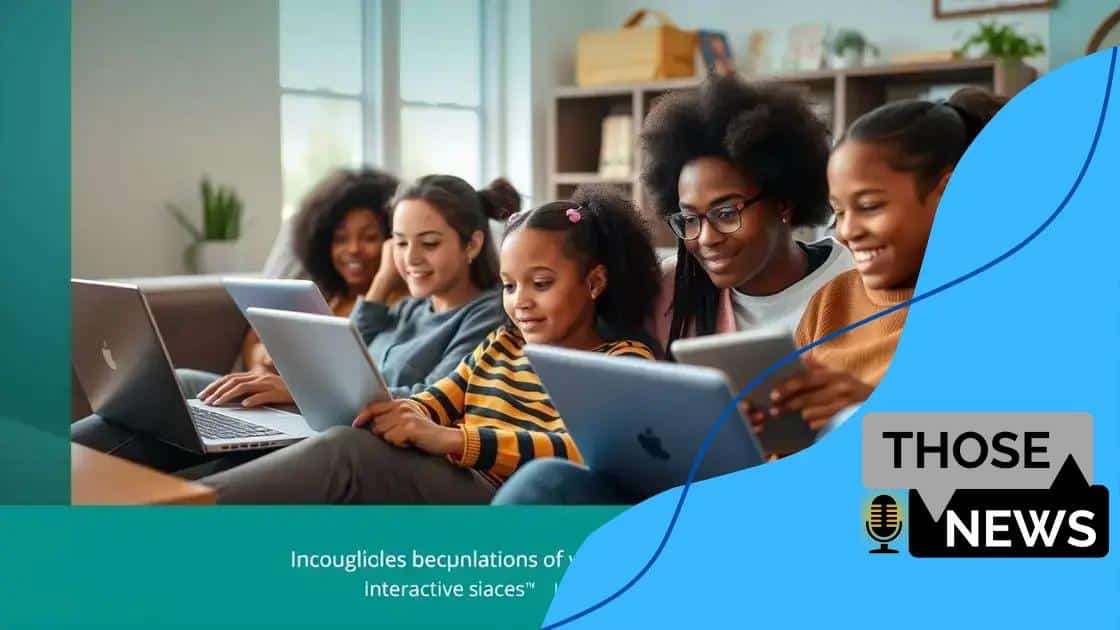Remote learning technology: Transform your education now

Remote learning technology enhances education by providing flexible, personalized experiences through tools like AI and VR, while also presenting challenges such as lack of interaction and technical issues.
Remote learning technology is changing the way we approach education, making it more flexible and accessible than ever. Have you thought about how these tools could enhance your learning experience?
Understanding remote learning technology
Understanding remote learning technology is essential in today’s fast-paced educational landscape. With the rise of digital tools, this technology enhances how students engage and learn.
Many institutions are embracing innovative technologies to facilitate learning from any location. This shift has made education more accessible to diverse learners, breaking down geographical barriers.
Key Terminology
When discussing remote learning technology, it is important to understand a few key terms:
- Learning Management Systems (LMS): Platforms that manage and deliver educational content online.
- Video Conferencing: Tools like Zoom and Google Meet that allow real-time interaction between instructors and students.
- Asynchronous Learning: Learning that does not require participants to be present at the same time.
- Collaborative Tools: Applications such as Google Docs that enable group work and discussions.
These elements contribute to a seamless learning experience. With interactive features, students can participate actively, sending messages or sharing documents in real time.
Advantages of Remote Learning Technology
The benefits of adopting this technology are numerous. First, remote learning promotes flexibility. Students can learn at their own pace, fitting studies around personal commitments. Additionally, it often results in greater engagement. For example, tools such as virtual simulations make learning more interactive and enjoyable.
Moreover, remote learning can save costs, both for institutions and students. Less physical infrastructure is needed, and students can save on commuting expenses. This option allows many learners to access quality education that was previously out of reach.
Overall, understanding remote learning technology empowers educators and students alike. It opens new possibilities for tailored educational experiences and prepares learners for a digital future.
Key features of effective remote learning tools
Key features of effective remote learning tools play a crucial role in enhancing the learning experience for students and educators alike. They enable a more interactive and engaging learning environment that can be tailored to individual needs.
Many effective tools include features that support collaboration and interaction. For example, incorporating video conferencing allows real-time discussions, bringing a sense of presence even in a virtual setting.
User-Friendly Interface
Firstly, a user-friendly interface is essential for any remote learning technology. It should be intuitive, enabling students and teachers to navigate easily without a steep learning curve. This accessibility promotes engagement as users can focus on learning rather than struggling to operate the platform.
Integrated Communication Tools
Effective remote learning tools also include integrated communication options. These may consist of:
- Discussion forums: Where students can ask questions and collaborate.
- Chat features: For quick messaging among peers and instructors.
- Feedback systems: Allowing for timely responses from educators regarding assignments.
- Notification alerts: Keeping students informed about important updates.
These features enhance interaction and ensure that learners remain engaged throughout their educational journey.
Accessibility and Flexibility
Moreover, accessibility is a key characteristic of effective remote learning tools. Platforms should be compatible with various devices, including tablets and smartphones. This flexibility allows students to learn whenever and wherever they feel most comfortable. By providing a range of resources, such as videos, readings, and interactive activities, these tools cater to different learning styles and preferences.
In addition, interactive elements such as quizzes or gamified learning experiences encourage participation and make learning fun. Ultimately, by focusing on these key features, educators can create enriching remote learning experiences that foster student success.
Benefits of remote learning for students

Benefits of remote learning for students are significant and transformative. This method of education offers flexibility and accessibility that traditional classroom settings often cannot provide.
One major advantage is the ability to learn at one’s own pace. Students can revisit lectures and materials as needed, ensuring they fully understand each topic before moving on. This self-directed approach can boost confidence and improve retention of information.
Increased Accessibility
Remote learning also enhances accessibility. With online tools, students from various backgrounds can engage in learning opportunities regardless of their location. For instance, learners requiring different accommodations can benefit from tailored resources available at their fingertips.
Cost Efficiency
Another important advantage is cost efficiency. Students save on commuting expenses, school supplies, and even meals. Many online programs often offer lower tuition rates than traditional institutions, making higher education more affordable for everyone.
- Flexibility in Schedule: Students can plan their studies around work or family responsibilities.
- Diverse Learning Resources: Access to a wide range of materials, including videos, articles, and interactive tools.
- Global Connections: Opportunities to connect with peers and instructors from around the world.
- Self-Motivation: Encourages students to take charge of their learning journey.
These benefits contribute to a more engaging and personalized education experience. In a digital world, remote learning fosters the development of critical skills such as time management and self-discipline.
Furthermore, the use of technology in learning prepares students for the demands of modern workplaces. Proficiency with various digital tools enhances employability and positions graduates for success in their careers.
Challenges faced in remote learning environments
Challenges faced in remote learning environments can impact both students and educators. While there are many benefits to online education, it is important to understand these obstacles to enhance the learning experience.
One major challenge is the lack of personal interaction. Students may feel isolated without in-person contact with teachers and peers. This can lead to decreased motivation, making it essential for educators to find ways to foster community despite physical distance.
Technology Issues
Additionally, technical difficulties can disrupt learning. Students may face issues such as:
- Unreliable Internet: Slow or unstable connections can make attending classes and accessing materials frustrating.
- Lack of Access to Devices: Not all students have the necessary devices, such as laptops or tablets, which can create equity issues.
- Software Challenges: Learning how to use various platforms can be overwhelming for some students.
- Cybersecurity Risks: Online learning environments must also address concerns related to privacy and data security.
Furthermore, staying focused during remote learning can be difficult. Students may encounter distractions at home, affecting their ability to concentrate on educational tasks. This situation emphasizes the need for good time management skills and personal discipline.
Adjusting to New Learning Styles
Remote learning also requires students to adapt to new learning styles. Many learners thrive in hands-on or interactive settings, which can be hard to replicate online. Educators must create engaging content that keeps students interested and inspires them to participate.
Finally, assessing student performance can be more challenging in a virtual environment. Without traditional tests, teachers need to find alternative ways to evaluate students’ understanding. This shift can complicate tracking progress and ensuring accountability.
Future trends in remote learning technology
Future trends in remote learning technology promise to reshape educational landscapes significantly. As technology evolves, so do the ways we teach and learn.
One key trend is the integration of artificial intelligence (AI) into remote learning platforms. AI can personalize learning experiences by analyzing students’ progress and adapting content to fit their needs. This means tailored lessons that help improve understanding and engagement.
Virtual Reality and Augmented Reality
Another exciting development is the use of virtual reality (VR) and augmented reality (AR). These technologies can create immersive learning environments that allow students to experience subjects in a more interactive way. For instance, students can explore historical sites or conduct virtual science experiments, enhancing their learning experiences far beyond traditional methods.
Data-Driven Insights
Moreover, data analytics is becoming more critical in education. By gathering and analyzing learning data, educators can gain insights into student behaviors and needs. This can help in identifying learning gaps and implementing strategies to assist those struggling.
- Adaptive Learning: Systems that change based on individual student performance.
- Gamification: Using game-like elements to motivate and engage students.
- Mobile Learning: Increased use of smartphones and tablets for learning on the go.
- Collaboration Tools: Enhanced platforms that promote teamwork, even in virtual settings.
In addition to these trends, the demand for soft skills training is rising. Remote learning technology will likely include components that help develop teamwork, communication, and problem-solving skills, preparing students for the workforce.
As these trends continue to emerge, educators and institutions will need to stay flexible and embrace innovations that enhance learning outcomes. This proactive approach will ensure they meet the diverse needs of future learners, keeping education relevant and effective.
FAQ – Frequently Asked Questions about Remote Learning Technology
What are the main benefits of remote learning for students?
Remote learning offers flexibility, personalized learning experiences, and access to a broader range of resources to enhance education.
How can technology enhance remote learning?
Technological tools like AI and VR create interactive and engaging learning environments, making education more effective and enjoyable.
What challenges do students face in remote learning environments?
Common challenges include lack of personal interaction, technical issues, and distractions at home, which can affect focus and motivation.
What future trends should we expect in remote learning?
Future trends include increased use of AI for personalized learning, enhanced collaboration tools, and greater focus on soft skills development.





